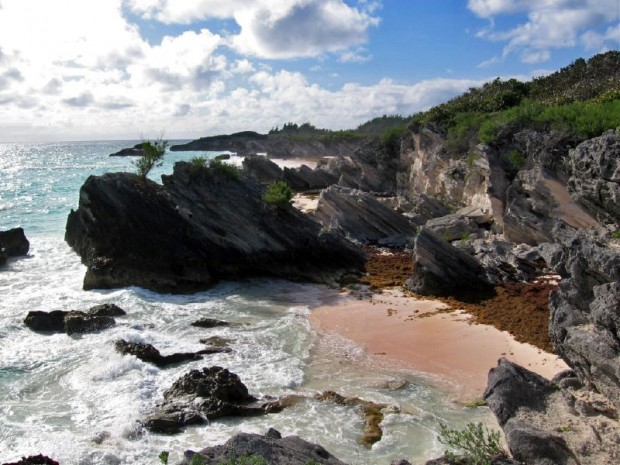Bermuda Features In Sea Level Study
Bermuda contains important sites where researchers have gone looking for answers to questions about how high the seas will rise in the coming decades, international scientists say.
Projections for sea-level increases in the year 2100 range from inches to several feet, or more. By pinpointing where shorelines stood on cliffs and reefs in Bermuda and the Bahamas during an extremely warm period 400,000 years ago, researchers hope to narrow the range of global sea-level projections for the future.
After correcting for what they say were the sinking of the islands at that time, a new study in the journal “Nature” estimates the seas rose 20 to 43 feet higher than today—up to a third less than previous estimates, but still a drastic change.
The new study infers that Greenland and West Antarctica ice sheets collapsed at that time, but not the even bigger East Antarctic Ice Sheet.
Bermuda’s cliffs: Clues to where shorelines stood 400,000 years ago
“Our study provides a simple explanation for these high beach deposits,” said study lead author Maureen Raymo, a climate scientist at Columbia University’s Lamont-Doherty Earth Observatory.
Average global sea level has risen eight inches since the 1880s. It is currently rising an inch per decade, driven by thermal expansion of seawater and melting of glaciers and ice sheets, including the still mostly intact ice sheets of Greenland and West Antarctica.
In its most recent report, the Intergovernmental Panel on Climate Change estimated that the seas could rise up to two feet by 2100; but that number could go higher depending on the amount of polar ice melt, and quantity of greenhouse gas emissions by humans.
The United Nations estimates that five feet of sea-level rise would be enough to swamp 17 million people in low-lying Bangladesh alone.
The cliffs and ancient reefs on Bermuda and the Bahamas have attracted fossil hunters for decades, and more recently, scientists investigating global sea level.
In a 1999 study in the journal Geology, Paul Hearty, a scientist at the University of North Carolina, Wilmington, estimated that during the period 400,000 years ago, the seas rose nearly 70 feet, in between glacial periods.
He hypothesized that the East Antarctic ice sheet must have partly melted to produce such a rise.
Researchers who unearthed the first fossilised breeding colony of albatrosses in Bermuda in 2003 concluded a massive jump in sea level — to more than 65 feet above its current height — drove the birds out 400,000 years ago.
No albatrosses live in Bermuda today or anywhere else in the North Atlantic.
Short-tailed albatross: Fossilised breeding colony found in Bermuda
In 2007, University of Hawaii scientist Gary McMurtry offered a competing hypothesis in the journal Sedimentary Geology: that a mega-tsunami generated by a collapsing volcano off the Canary Islands created the high-water mark.
The new study comes up with a different take. It factors in the loading and unloading of ice from North America during the ice ages preceding the sea-level rise.
As the ice sheets grew, their weight pushed down the land beneath them, while causing land at the edges of the continent—including Bermuda and the Bahamas–to bulge up, says Raymo. When the ice pulled back, the continent rebounded, and the islands sank.
“Bermuda and the Bahamas are not a pristine measure of the volumes of ice that melted in the past, because they’re contaminated by effects left over from the ice ages,” said study coauthor Jerry Mitrovica, a geophysicist at Harvard University.
The new study infers that the huge Greenland and West Antarctic ice sheets indeed collapsed at the time, but that loss from the even vaster East Antarctic Ice Sheet was negligible.
Today, both Greenland and West Antarctica are losing mass in a warming world, but signals from East Antarctica—about eight times bigger than the other two combined–are less clear. Raymo said the study helps show that “catastrophic collapse” of the East Antarctic ice is probably not a threat today. “However, we do need to worry about Greenland and West Antarctica,” she said.
The study’s revised estimate of 20 to 43 feet makes sense, said sea-level rise expert Mark Siddall, a climate scientist at the University of Bristol who was not involved in the study.
But, he added, it would probably take hundreds to thousands of years for such a rise to occur again.
“We’re moving from a place of disagreement about sea level estimates from this past period to one consistent theory that reconciles data from diverse geographic areas,” he said.
Read More About
Category: All, Environment




Who did not think before they authorized the huge empty buldings/condos?